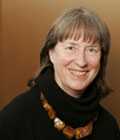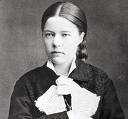CLIO Talks Back

Karen Offen
United States
Archive
- Jun 2011
- May 2011
- Apr 2011
- Mar 2011
- Feb 2011
- Jan 2011
- Dec 2010
- Nov 2010
- Oct 2010
- Sep 2010
- May 2010
- Apr 2010
- Mar 2010
- Feb 2010
- Jan 2010
- Nov 2009
- Oct 2009
- Aug 2009
- Jul 2009
- Jun 2009
- May 2009
- Apr 2009
- Mar 2009
- Feb 2009
- Jan 2009
- Dec 2008
- Nov 2008
- Oct 2008
- Sep 2008
- Aug 2008
- Jul 2008
- Jun 2008
- May 2008
- Apr 2008
I.M.O.W.'s debut blog, Clio Talks Back, will change the way you think about women throughout history! Be informed and transformed by Clio Talks Back, written by the museum's resident historian Karen Offen.
Inspired by Clio, the Greek muse of History, and the museum's global online exhibitions Economica and Women, Power and Politics, Karen takes readers on a journey through time and place where women have shaped and changed our world. You will build your repertoire of rare trivia and conversation starters and occasionally hear from guest bloggers including everyone from leading historians in the field to the historical women themselves.
Read the entries, post a comment, and be inspired to create your own legacies to transform our world.

www.sweden.se
Selma Lagerlöf as a girl

www.nobelprize.org
Selma Lagerlöf as a Nobel laureate
Clio introduces Selma Lagerlöf, Nobel Prize for Literature 1909
2010-01-21 10:58:08.000
Just over a hundred years ago, a Swedish writer named Selma Lagerlöf (1858-1940) received the Nobel Prize for Literature. She was the first woman in the world to be recognized for her literary contributions. A few years later she became the first woman elected to the Swedish Academy. The University of Uppsala had already honored her with an honorary doctorate. Who was this woman?
Selma Lagerlöf was a prodigious and popular writer of stories and novels. Her works appeared in translation in many other languages besides Swedish and English. After giving up her work as a teacher, she traveled widely and drew from her experiences in other lands, including Italy, Egypt and the Holy Land. One of her best known works was The Wonderful Adventures of Nils, published in 1907, a fanciful story about a miniature boy who flew all over Sweden on the back of a gander, learning the geography of his country and encountering many wonderful creatures. She also wrote long novels, beginning with Gösta Berlings Saga (1891), and including Jerusalem (1901-1902), about a group of peasants who moved to Jerusalem for religious reasons, but were conflicted about having left their farms in Sweden.
Lagerlöf was by no means the first celebrated woman writer in Swedish history. Indeed, the first Swedish novel, Hertha (1855), by Fredrika Bremer, had attacked the laws ? the system of patriarchal guardianship over daughters embodied in Sweden?s ?Paternal Statutes? of 1734. This novel made such an impression, that the government modified those paternal statutes in 1858, and in 1872 changed them again to acknowledge the full legal emancipation of unmarried Swedish women at the age of twenty-five. Sometimes literary works can have a vast impact on social institutions and Bremer?s writings certainly did. So did those of Selma Lagerlöf.
One of Selma Lagerlöf?s most important post-Nobel speeches was given in June 1911to the congress of the International Woman Suffrage Alliance, meeting in Stockholm. Entitled ?Home and State? [Hem och Stat in Swedish], she presented her case for woman suffrage: Women, she said, want to help men change the state into a home for the nation. Swedish women did obtain the vote before many others.
The Nobel prize brought Selma Lagerlöf a vast amount of money. She used that money to buy back the family estate Mårbacka, in the Värmland, near Lake Vanern in the southern part of Sweden. It had been sold in 1885 following her father?s death, to Lagerlof?s great regret. The author had drawn deeply on the oral history and folk tales of this region in many of her writings. There, in the Värmland, ?women were still the preservers of tradition and performed the family?s storytelling. . . mythical notions were still alive? (Delblanc, p. 12). To her, this place was a spiritual as well as a physical home.
This very successful authoress was also very generous to others. One author (Berendsohn, p. 31-32) wrote of her in 1931: ?Selma Lagerlöf gives away a great part of her income, not only to relieve distress far and wide, but to further cultural and scientific purposes?. She has given large sums towards the cutting of a canal and the improvement of the roads. To a ?Gosta Berling Fund? for elderly and needy authoresses she devoted all the proceeds of the ?Gosta Berling? film. It is not without reason that she is accounted as a good fairy in her home country.?
Superbly talented, honored, gracious, and generous ? these words epitomize this superb Swedish writer, who overcame a crippling childhood deformity to become a great figure in world literature.
To learn more about Selma Lagerlöf:
Vivi Edström. Selma Lagerlöf. Translated by Barbara Lide. Boston: Twayne, 1984.
Walter A.Berendsohn. Selma Lagerlöf: Her Life and Work. Adapted from the German by George F. Timpson, with a preface by V. Sackville-West. London: Ivor Nicholson & Watson Ltd., 1931.
Sven Delblanc. Swedish Portraits: Selma Lagerlöf. Published by the Swedish Institute, 1986.
Solving the Paid Work-Family Conflict for Women
2010-01-20 17:11:54.000
There has been a great deal of stir in the American media lately about how women who work for pay and are mothers can balance career and family, without an extended family – or a village – to help out. One solution proposed is “Getting to 50/50” in the household, with husbands and fathers taking more responsibility for raising children and sharing household work.
During the last two centuries other solutions for the rearrangement of domestic economy have been proposed. Clio brings to your attention one of these, a communal, cooperative solution that later inspired the kibbutz system in Israel. Early in the nineteenth century, the utopian thinker Charles Fourier elaborated such a system at great length. His ideas were taken up by many others. One of the more successful experiments of this type took place in France – the Familistère at Guise (Aisne), under the direction of a disciple of Fourier, Jean-Baptiste Godin.
Jean-Baptiste Godin (1817-1888) had made a fortune in ironworking. He was the founder and guiding spirit of the most important French worker-city and industrial complex, which he established in northeastern France in 1859, based on Fourierist principles. The Familistère supported its activities through pioneering the manufacture of cast-iron stoves. The facilities included hundreds of family lodgings, stores, a restaurant, a workingmen’s club, a library, covered courtyards, vast gardens and agricultural plots, professional and primary schools, and a nursery for infants and pre-school children. It was among the first planned communities.
Many visitors from other European countries and North America attested to the success of the project, which lasted until 1968, when it was acquired by a German firm. It is now open as a tourist attraction.
In this published letter to Theodore Stanton (son of the American suffrage leader, Elizabeth Cady Stanton, and compiler of an important work on the woman question in Europe, Godin describes the arrangements made at the Familistère to free women for productive labor through the socialization of household labor and childcare.
This is Godin’s description, as translated and published in Stanton’s essay on France in The Woman Question in Europe (New York & London: G. P. Putnam’s Sons, 1884), pp. 307-309.
“The foundation of the Familistère reposes on principles which are a synthesis of the practical ideas forced upon the attention of the world by the St. Simonian, phalansterian and communistic schools of the early part of this century. But it is above all for women and children that our creation at Guise has proved a happy event. The Association of the Familistère is, I think, the only institution which has, up to the present time, put into practice respect for the rights of women, who are treated as the equal of men in all the affairs of life. This idea of the equality of the sexes was borrowed from Fourier. The Familistère could not change the laws of French society, but as members of the Association, women enjoy all the rights of men. They may aspire to all the honors at the disposal of the Association; they are electors and eligible [Ed.: to run for office]; they may form a part of all committees and councils. They perform these duties with faithfulness, and have shown themselves inaccessible to cabal, which has not always been the case with the men.
“In order that women may profit by the social liberty to which the present current of ideas is leading them, a change must be made in the system of family life: domestic economy must be modified and perfected. The emancipation of women will remain in the domain of speculation, as long as our institutions and customs impose on the father and mother the entire responsibility of the care of the family. The Familistère has solved this problem by assuming the bringing up of the children from the moment of their birth, so that the mother has to bestow on them only her milk and caresses, and the family, its tenderness and affection. But even in the absence of mother and family the children are not neglected. They always receive the closest attention. At every stage of their growth the children are under the eye of the Association. Separated into nine divisions in nine different rooms, each division has its nurses and teachers, who give instruction in keeping with the age of their pupils. In this way the mother and father can confer on their offspring the delights of family life, without inflicting on them, at the same time, any of its discomforts. The care and education of the children – which are the same for both sexes – being thus assumed by the Association, the duties of maternity are reduced to nursing during the early months of the child, and the mother is not hindered from attending to her other occupations. Women, therefore, find themselves emancipated, in so far as they desire it, from one of the most monopolizing obligations; they recover their liberty and may devote themselves to work and culture.
“In order to introduce this innovation, it is indispensable that the isolated habitation give place to the common dwelling, the phalanstery or social palace, so that the bringing up of children may be made a distinct organized part of the family system. The commune, therefore, must be architecturally reformed, and all the common household duties be placed in proximity to the home. It is necessary, furthermore, to bring about the division of domestic labor; to establish for the children a nursery, infant schools, primary schools, etc; to organize kitchens, laundries, public halls, etc. Only in this way is it possible to reconcile household duties and family cares with the exercise, on the part of women, of civil and political rights and lucrative employments.”
Clio wants to hear your views on the Familistère solution. Do you think it is possible still in our own time? Can a solution like this work in other parts of the world? What are the essential elements? Must the community be relatively small? What, indeed, do women want, especially mothers who also seek economic independence and fulfilling work outside the home?
Suggested further reading:
Theresa M. McBride, “Socialism and Domesticity: The ‘Familistère’ at Guise,” International Labor and Working-Class History, no. 19 (1981), pp. 45-46.
Solutions Sociales de J. B. A. Godin, ed. J. F. Rey and J. L. Pinol (Quimperle: La Digitale, 1980; orig. publ. 1871).
On the Web: http://www.familistere.com

